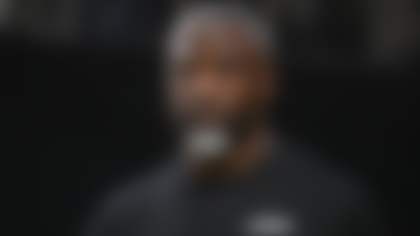By Bill Bradley, contributing editor
Scott Hallenbeck has been the executive director USA Football since 2005.
During the past two years a big part of his job has been creating and leading the Heads Up Football program. That's an initiative aimed at making the game safer and emphasizing proper tackling and football fundamentals, developed by USA Football and supported by the NFL.
Hallenbeck talked with NFL Evolution last month about the progress he has seen in the Heads Up Football program and what he sees in the future for youth football safety during USA Football Month in the NFL.
As you enter the third season of Heads Up Football, how would you evaluate the program?
The second year was a big year in terms of firsts for us. It was the first year that we had the National Federation of State High School Associations on board. The year before it was just a pilot program for high schools. Overall, the progress has been significant ... Youth football has bought into it incredibly. It's been a pretty dramatic growth spurt for us and it shows how much love people have for the game.
How tough was it to recruit teams and leagues when the program first started?
We went after the top-500 largest youth leagues in the U.S. In the country, there's 10,000 organizations. By focusing on the biggest leagues, it allowed us to make dramatic headway in the quickest possible time. That clearly helped the process. And the beauty of that is those are probably the most influential leagues and clubs in the country. Getting them engaged in participating in our second year, I believe will have even stronger impact in years three, four and five with those medium- and smaller-sized organizations that we will be targeting as we go forward.
What was recruiting like at the beginning?
It was a matter of getting out and contacting the head of these very large organizations, ultimately meeting with their boards. We gave them a consistent presentation about the program and the issues facing our sport and how we plan to proactively address it, which was the Heads Up Football program. The good news is in most of those cases, these guys signed on. That's what probably has driven us to 100 percent growth the second year -- what we call the "Top 500" strategy.
We can only imagine how many frequent flier miles and rental cars your organization has used the past year.
Well, everything had to expand. The first year we thought we would get between 100 and 500 of those leagues, but we ended up with nearly 2,800 leagues. Now we're effectively doubling it. We had to go from nearly 30 Master Trainers to now 80. We had to go from roughly 100 player safety coach trainers to now about 250. Everything had to expand. Naturally, we expanded the staff we have (at the Indianapolis office). ... and every aspect of our business to accommodate program's reach.
The good news is we don't necessarily travel from this office to every single location. We strategically identified trainers and/or regional managers to help cover the country. But the bottom line, one way or another, we have to cover the country and talk to grass roots organizations, which means you're getting into the communities and backyards all over this country. The good news is the outreach and efforts seem to be working. The response from these commissioners and ultimately their clubs is very positive. The media response has been incredibly positive.
People are seeing that there's action-based, rationale programming going on to try to make a better, safer game. That's where the credibility and the faith and trust in USA Football is paying off. It's not some PR stunt. This is genuine, real people getting out there and doing hands-on training and teaching and tracking progress and interfacing with coaches and parents. It's really going to blossom and come to life (in August) when most youth football organizations crank up.
You seem to have great buy-in from former NFL players like Buddy Curry and Doug Cosbie. How does this help the program?
They are great Master Trainer examples. Terrific guys who are doing this because they genuinely care. They have the benefit of playing at the highest level and they have a platform in which they can give back. Buddy Curry has a foundation and a great relationship with the Atlanta Falcons while doing terrific work down there. Doug Cosbie, now a full-time high school coach at a really prominent school in Honolulu, is really situated as an influencer and that resonates. He gets out and says, "I not only believe in this, but I'm actually doing it at my high school."
I can imagine some high school coach saying that this isn't lip service. This is a sincere commitment to executing this program. ... Where now we nearly have almost 1,000 high schools that have signed up -- plus multiple state associations that were in discussions with about adopting Heads Up Football across their entire state. You know about Maryland, we've been talking to (Hawaii), Louisiana, and the state of Washington. ... And I'm in discussions with Texas (and California). Big huge swaths of high schools ... are talking about adopting Heads Up Football.
What has been the most gratifying thing you have seen the past few years as part of Heads Up Football?
Actually, I would say the engagement by the high school coaches. I'm enamored and very proud of the response at the youth level. But the really strong influencers in most communities is the high school coach. The fact that they are coming to us, saying "We are dealing with a lot of the same problems. Whether it be concussions; whether it be safety; whether it be the concern of parents. We have our own leadership, our principals, our athletic directors, our superintendents. They're asking us to create a better, safer game." They have analyzed a lot of different things and they yet come back to USA Football and they say, "We believe in the things you're doing. We might want to add a method or help you to continue to evolve this, but we're in. We believe in what you're doing."
What are the significant behavior changes you have seen so far?
The greatest behavior change is what's to come. That is, think logically about an eight- or 10- or 12-year old player being taught the elements of Heads Up Football today and those that will be added as time goes on. The consistent technique and consistent terminology can carry right on up to high school. That's the single greatest advancement in critical behavior change that we will see in this program. A young man or woman can be taught Heads Up tackling, for example, it's the same technique and the same terminology at age eight, 10, 12, 13, 14, 16 or 18. That is dramatic.
When I talk to many coaches -- college, high school or even youth -- they swear they teach tackling, but they talk about it differently. Imagine for younger players, that confuses them. When you think about the different steps in progression of tackling, if you're talking about it, especially to a younger person, it's going to give them pause. If we can wipe that away in one of the most complex areas of the game, then we've truly created behavior changes.
Has the rollout gone as you liked? Have there been any hiccups along the way as you've tried to change football culture?
We don't suggest for a second that we have unearthed all of the answers. We continue to learn from our constituents. It's not like we send out the program, hit the green "Go" button and everything is perfect. We have to work with them. We've learned we have to start earlier with our player safety coach training. We've got to work more diligently with our youth league commissioners that they follow through on the different compliance elements of the program. That carries right into high schools. I would say that we're very pleased with the progress of the rollout. We learn every day about ways to improve it.
Has the controversial series "Friday Night Tykes" affected your rollout?
"Friday Night Tykes," when people actually saw it, they were horrified like anyone else. Ironically, it's actually been one of our best ways to address the need for a program like Heads Up Football. When I sat with (commissioner) Mike Slive of the Southeastern Conference, one of the first things I showed their leadership was the "Friday Night Tykes" 30-second promo. I tell them, "This is one of the few times when I've seen the episodes worse than the promos." Mike Slive's response was, "You've got me. What can we do to help?" It scares people to no end. If that is even remotely what people think youth football is, we have serious challenges. Like I said, we show that whenever we make presentations to youth commissioners, high school athletic directors or coaches and certainly other stakeholders in football. Then we follow up with why we created Heads Up Football and detail the elements of the program. That has proven to be a very powerful aide to our presentation.
Was there one group that adopted HUF that got the ball rolling and convinced others to jump on board?
In our first year, random subset of those 10,000 organizations, including everyone from Pop Warner to a myriad of independents. In the second year, the fact that Pop Warner and their leadership embraced this -- and they've been terrific. They have helped us get toward 100 percent of their members signing on. I give a lot of credit to Pop Warner and their leadership for embracing this program and pushing it through.
You now have four of the Big Five power conferences involved. How important has it been to get major college conferences adopt the program?
Just like the NFL, the 32 NFL teams and coaches have great influence. To expand that to the college level, they reach a greater number of players than just those that make it to the NFL. Inarguably, at the high school level, where there is even a greater number of schools, it gives us what we call an influencers' strategy. We reach these conferences with their coaches and their athletic directors, they believe in this program and endorse it. In fact, in many cases they engage in it.
A good example of that is (coach) Brady Hoke of Michigan. He has adopted Heads Up Football into his youth and high school-based camps. If you are a high school coach and you go to the University of Michigan camp, he is teaching Heads Up Football. He did that on his own. ... In addition, he'll travel around Michigan and Ohio talking to those coaches, preaching Heads Up Football. It doesn't get any better than that. There are many across all of the different conferences that have embraced this in a great way. You can only imagine the power and the influence which that has when those coaches are standing in front of high school coaches or just parents.
What are the next step for Heads Up Football? What you like to see it do in the future?
Naturally we want to ultimately see all 10,000 youth football organizations and all 15,000 high schools with varsity programs to be practicing Heads Up Football. The other thing we want to do is continue to evolve it. A lot of times people say to us, "What about running? What about blocking? What about other safety-oriented issues that need to be addressed, like sudden cardiac arrest?" We couldn't agree more. All of those need to be addressed, but we needed to walk before we could run. We have a rollout schedule. Next we want to put out Heads Up running and Heads Up blocking. Over the next couple years, we will continue to roll out and incorporate new safety elements and better football elements to continue to evolve and improve the program.
The other thing we want to do is continue to find ways to get in front of more and more parents. I think we do a reasonably good job of that now. That's an element that's further down the continuum of the multiple steps of Heads Up Football. And we want to make sure that parents thoroughly understand Heads Up Football. We need to find as many ways as possible to get the program in front of them.



